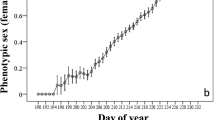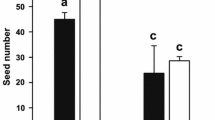Abstract
The flower heliotropism of Anemone rivularis (Ranunculaceae) was investigated on the Yulong Snow Mountain, near Lijiang in the northwest of the Yunnan province of China. We discovered that tepals in this species drive the peduncles to track the sun, and that this flower heliotropism was likely an adaptation for parental environmental effects on reproductive fitness. In brief, A. rivularis flowers retained sun-tracking behavior following removal of pistils and stamens, but lost heliotropic movement, if tepals were removed. Light is the major factor to affect floral heliotropism, the tepal-received light signal was in the blue frequency. Meanwhile, the peduncles were found to bend significantly on the top portion of both control flowers and those lacking pistils and stamens, but instead of keeping a vertical peduncle orientation in flowers with tepals removed. Furthermore, the floral temperature was steadier, and seed sizes and numbers were greater for control flowers than for flowers with tepals removed. Therefore, we conclude that the tepals trigger the flower heliotropism in A. rivularis and play an important role on not only increasing but also keeping optimal thermal condition of flower interior. We further conclude that flower heliotropism enhances the pollen viability and seed production, resulting in higher reproductive success for this alpine species.







Similar content being viewed by others
References
Britz SJ (1979) Chloroplast and nuclear migration. In: Haupt W, Feinleib ME (eds) Physiology of plant movements. Springer, Berlin
Corbett AL, Krannitz PG, Aarssen LW (1992) The influence of petals on reproductive success in the arctic poppy (Papaver radicatum). Can J Bot 70:200–204
Dafni A (1996) Autumnal and winter pollination adaptations under Mediterranean conditions. Bocconea 5:171–181
Erickson AN, Markhart AH (2002) Flower developmental stage and organ sensitivity of bell pepper (Capsicum annum L.) to elevated temperature. Plant Cell Environ 25:123–130
Galen C (2006) Solar furnaces or swamp coolers: costs and benefits of water use by solar-tracking flowers of the alpine snow buttercup, Ranunculus adoneus. Oecologia 148:195–201
Galen C, Stanton ML (2003) Sunny-side up: flower heliotropism as a source of parental environmental effects on pollen quality and performance in the snow buttercup, Ranunculus adoneus (Ranunculaceae). Am J Bot 90:724–729
Hart JW (1990) Plant tropisms and other growth movements. Unwin Hyman, London
Hocking B, Sharplin CD (1965) Flower basking by arctic insects. Nature 206:215
Kevan PG (1972) Heliotropism in some arctic flowers. Can Field Nat 86:41–44
Kevan PG (1975) Sun-tracking solar furnaces in high arctic flowers: significance for pollination and insects. Science 189:723–726
Kjellberg B, Karlsson S, Kerstensson I (1982) Effects of heliotropic movements of flowers of Dryas octopetala L. on gynoecium temperature and seed development. Oecologia 54:10–13
Knutson RM (1981) Flowers that make heat while the sun shines. Nat Hist 90:75–80
Koller K (1980) Solar-tracking (phototropism) in leaves of Lavatera cretica and Malva parviflora. Year book, Carnegie Institution of Washington, Washington, pp 72–75
Koller D (1986) The control of leaf orientation by light. Photochem Photobiol 44:819–826
Körner C (2003) Alpine plant life: functional plant ecology of high mountain ecosystems, 2nd edn. Springer, New York
Krannitz PG (1996) Reproductive ecology of Dryas integrifolia in the high Arctic semi-desert. Can J Bot 74:1451–1460
Kudo G (1995) Ecological significance of flower heliotropism in the spring ephemeral Adonis ramosa (Ranunculaceae). Oikos 72:14–20
Lang ARG, Begg JE (1979) Movements of Helianthus annuus leaves and heads. J Appl Ecol 16:299–305
Luzar N, Gottsberger G (2001) Flower heliotropism and floral heating of five alpine plant species and the effect on flower visiting in Ranunculus montanus in the Austrian alps. Arct Antarct Alp Res 33:93–99
Molgaard P (1989) Temperature relations of yellow and white flowered Papaver radicatum in north Greenland. Arct Antarct Alp Res 21:83–90
Myers N, Mittermeier RA, Mittermeier CG, Fonseca GAB, Kent J (2000) Biodiversity hotspots for conservation priorities. Nature 403:853–858
Orueta D (2002) Thermal relationships between Calendula arvensis inflorescences and Usia aurata bombyliid flies. Ecology 83:3073–3085
Patino S, Grace J (2002) The cooling of convolvulaceous flowers in a tropical environment. Plant Cell Environ 25:41–51
Patino S, Jeffree C, Grace J (2002) The ecological role of orientation in tropical convolvulaceous flowers. Oecologia 130:373–379
Seymour RS (2001) Biophysics and physiology of temperature regulation in thermogenic flowers. Biosci Rep 21:223–236
Sherry RA, Galen C (1998) The mechanism of floral heliotropism in the snow buttercup, Ranunculus adoneus. Plant Cell Environ 21:983–993
Simons P (1992) The action plant: movement and nervous behavior in plants. Blackwell, Cambridge, MA
Smith AP (1975) Insect pollination and helioptropism in Oritrophium limnophilum (Compositae) of the Andean Paramo. Biotropica 7:284–286
Stanton ML, Galen C (1989) Consequences of flower heliotropism for reproduction in an alpine buttercup (Ranunculus adoneus). Oecologia 78:477–485
Stanton ML, Galen C (1993) Blue light controls solar-tracking by flowers of an alpine plant. Plant Cell Environ 16:983–989
Stirton CH (1983) Nocturnal petal movements in the Asteraceae. Bothalia 14:1003–1006
Totland O (1996) Flower heliotropism in an Alpine population of Ranunculus acris (Ranunculaceae): effects on flower temperature, insect visitation, and seed production. Am J Bot 83:452–458
Tsukaya H, Fujikawa K, Wu SG (2002) Thermal insulation and accumulation of heat in the downy inflorescences of Saussurea medusa (Asteraceae) at high elevation in Yunnan, China. J Plant Res 115:263–268
Vogelmann TC (1984) Site of light perception and motor cells in a sun-tracking lupine (Lupinus succulentus). Physiol Plant 62:335–340
Wada N (1998) Sun-tracking flower movement and seed production of mountain avens, Dryas octopetala L. in the high arctic, Ny-Alesund, Svalbard. Proc NIPR Symp Polar Biol 11:128–136
Wu ZY, Wu SG (1998) A proposal for a new floristic kingdom (realm). In: Zhang AL, Wu SG (eds) Floristic characteristics and diversity of East Asian plants. China Higher Education Press/Springer, Beijing/New York, pp 3–42
Young TP (1984) Solar irradiation increases floral development rates in Afro-alpine Lobelia telekii. Biotropica 16:243–245
Young LW, Wilen RW, Bonham-Smith PC (2004) High temperature stress of Brassica napus during flowering reduces micro-and megagametophyte fertility, induces fruit abortion, and disrupts seed production. J Exp Bot 55:485–495
Acknowledgments
We are grateful to Wei Zhou and Chun-Fang Li for their kind assistance with experiments and statistics. We also thank Dr. Zachary M. Larson-Rabin from the University of Wisconsin-Madison, USA, for revising an earlier version of this manuscript. This study was supported by National Basic Research Program of China (973 Program, No. 2007CB411603).
Author information
Authors and Affiliations
Corresponding author
Rights and permissions
About this article
Cite this article
Zhang, S., Ai, HL., Yu, WB. et al. Flower heliotropism of Anemone rivularis (Ranunculaceae) in the Himalayas: effects on floral temperature and reproductive fitness. Plant Ecol 209, 301–312 (2010). https://doi.org/10.1007/s11258-010-9739-4
Received:
Accepted:
Published:
Issue Date:
DOI: https://doi.org/10.1007/s11258-010-9739-4




